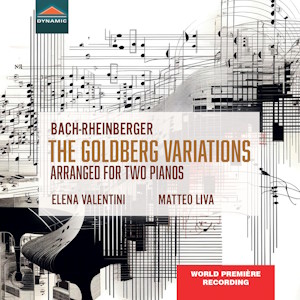
Johann Sebastian Bach (1685-1750)
Goldberg Variations (arr. for two pianos, Josef Rheinberger, 1883)
Elena Valentini, Matteo Liva (pianos)
rec. 2022, Sala Concerti Conservatorio Benedetto Marcello di Venezia, Italy
Dynamic CDS8002 [70]
The word “iconic” is one of the most overused in the English language these days, but Bach’s Goldberg Variations for two manual harpsichords is undoubtedly an iconic work in Western music. Published in 1741, it represents the pinnacle of what could be achieved on the harpsichord at the time. The variations are not so much variations on the Aria that opens the work but on the bass line and chord progression that supports it. This opens up the possibility of many flights of fancy far removed from obvious variations on the melody itself. There have been many recordings of the original on harpsichord and many recordings on piano where the lack of two keyboards adds to the already considerable difficulty for the performer in negotiating interlocking hand patterns. Bach’s original has no tempo indications and there are as many approaches to speed and dynamics as there are performances. Rheinberger, however, gives each section a metronome mark and the score is full of phrasing and expressive directions.
Baroque music, like Baroque architecture is often highly ornamented and Bach’s aria is no exception. It is therefore a shock to hear that Rheinberger’s statement of the theme, divided between the two players, is devoid of any ornamentation; it is rather like seeing a close relative naked. After years of hearing Bach’s ornaments it is odd, although Wilhelm Kempff also used to play the aria without ornament. The duo plays it at a good speed – no wallowing here – which sets us up for what is to come. The first variation is also a surprise, as Rheinberger cleverly plays an even more pared down version of the aria on top of Bach’s original. Throughout, Rheinberger flexes hi-contrapuntal muscles, much as Bach did. In fleshing out the textures of the original, there is often much busy finger work, but the duo is not always as tightly together as they could be, which leads to some occasional lack of clarity. The minor key variations, numbers 15, 21 and 25, are well captured in a rich, sonorous sound. The balance between the two pianos throughout is exemplary.
In the original, Bach magically restates the opening aria as the end of the work. In Rheinberger’s version he ends with variation 30, the quodlibet. This is a mistake on his part, as the restatement is the perfect completion to the journey. Without the restatement, the quodlibet, an assemblage of a number of popular tunes of the day, needs to be magisterial – something the material is not up to.
Rheinberger’s aim in 1883 in arranging the work was to make it more popular to audiences of the day and it needs to be viewed in this light. With decades of authentic performance to look back on, Romantic additions to Bach can be jarring – but Rheinberger clearly loved the work, as do these performers, and there is much that a 21st century audience can get out of it. For anyone interested in a more radical take on Bach, Robin Holloway’s Gilded Goldbergs from 1998 (Hyperion CDA 67360) is well worth investigating.
Paul RW Jackson
Help us financially by purchasing from




















